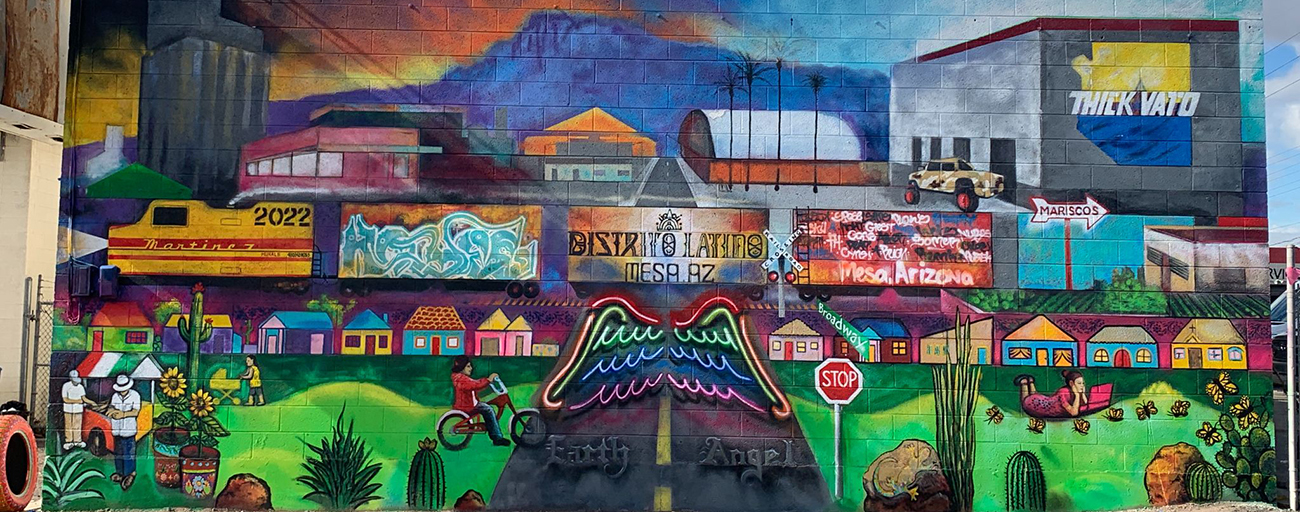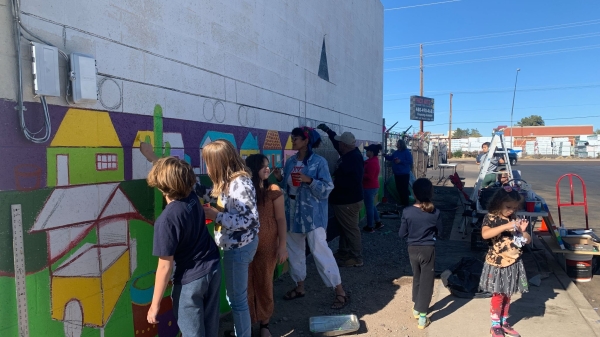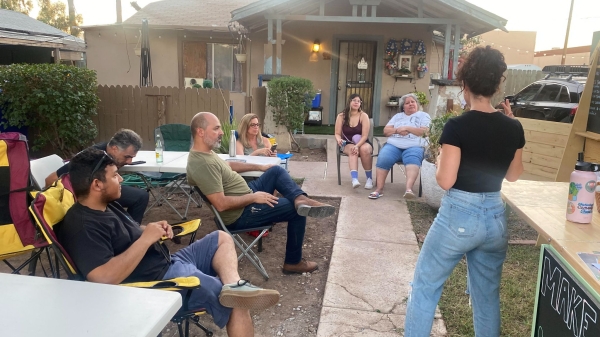
Building wealth and preventing displacement
Ryan Winkle, RAIL CDC
Background
Distrito Latino is a commercial corridor and grouping of Latino neighborhoods in a Latino, historically migrant worker family area, outside of Downtown Mesa. With a population of over 80% Black, Indigenous, and people of color (BIPOC), low-income, and Spanish-speaking-only households, the Distrito Latino & Mesa Southside neighborhoods are at high risk for displacement and financial hardships in the face of a surging real estate market and large city infrastructure investments and decades of policy rooted in white supremacy. This project is timely because there are currently more than $1.27 Billion dollars in development projects in downtown Mesa. On the surface, people are excited about this investment flowing into downtown Mesa, but few people are paying attention to the potential challenges that this investment will bring to the existing businesses and neighborhoods adjacent to downtown, which we refer to as the Distrito Latino / Southside Neighborhoods.
Area Context: The Distrito Latino is made up of 76% Latinx with 37% of the population being foreign-born, and Spanish as the primary language in 69% of the households. The median household income of the neighborhoods is less than $32,000 and 23.9% of the population is below the poverty line. It is on the front lines of potential displacement with about 65% of the households being renter-occupied, and a low owner-occupied rate for commercial properties as well. With all of these “Challenges”, the Distrito Latino along the Broadway corridor has a strong neighborhood-scale business district with thriving mercados, panaderias, carnicerias, retail, a variety of light manufacturing, and a very underrated Latino food scene.
Project Goals
- Use data and lived knowledge to build community-based tool sets, including organized residents and small business owners, to build layers of power.
- Use established communication channels and organized community power to move forward a wealth-building and anti-displacement strategy as a community response to adverse conditions.
- Use these strategies to implement community-based solutions that are sustainable over time and build overall resiliency during adverse conditions.
Research questions
-
What are the immediate and long-term actions that individuals and groups can take to establish community-based power?
-
Which community-based actions are best suited to address each decision-making layer or “chain-of-command” for the optimal outcome?
-
What community-based strategies have the best possible outcomes in implementation?
Methods and findings
This Project is based on years of trust building and doing community development work in the Distrito Latino and Southside Neighborhoods by RAIL CDC and partners. A majority of the data collection and community research specifically for this project started in 2021 with a series of community assessments and interviews using two innovative community-led models: pláticas (driveway conversations) and caminatas urbanas (walking audits). This was complemented by a robust small business technical assistance program. 2021 ended with a strong knowledge of the community, the habits of people in the neighborhood, community assets, and SWOT analysis, and identified leaders.
2022 work built upon the deep community engagement and data collection and took the necessary next steps in taking action based on the community's expressed need for wealth building and anti-displacement strategies. Throughout the year we continued the Platicas and Caminetas Urbanas (Walking Audits) while at the same time making asks of residents to take action and participate in community-building activities. RAIL CDC invited community leaders to spearhead and work with artists, placemaking professionals, small businesses, and the RAIL CDC team on community engagement projects.
- Multiple community mural projects with attached food and art events were created. -A pop-up park event led by the neighborhood which included temporary bike lanes, public furniture, and painted crosswalks.
- A heat action plan was initiated with heat readiness for school-aged children.
- A community zine, highlighting legacy and active residents was created.
- Residents and Small business owners were invited to attend community input events and city events
While these creative and engaging projects were happening, RAIL CDC worked with community partners and funders to build out the programmatic side of this.
- Address the need for small businesses and other consultants who look like the people we are working to empower.
- Address the need for credit building, workforce development opportunities, and access to capital for residents and small businesses
- Address the need for residents and small businesses to gain power and some level of control in decision-making processes happening in the Distrito Latino and Southside neighborhoods
- Address policies rooted in white supremacy and how those policies are enforced in the Distrito Latino and Southside neighborhoods
- Address small business development needs and opportunities for neighborhood-based and creative entrepreneurship
- Address how to measure results over time
Partners
-
Knowledge Exchange for Resilience (KER) - Data requests, KER cohort 2022
-
Rail CDC (https://railcdc.org)
-
ASU Healthy Urban Environments - Heat Action Project - Heat Readiness in Schools
-
Local Muralist - David Martinez
-
Local Installment Artist - Scarlet Flores
-
Local Community Organizers Jacob Martinez & Saul Pacheco
-
Patchwork Community Inclusion - Augie Gastelum
-
Creative Community - Jen Gastelum - Placemaking and Art Engagement
-
Bookman & associates - Joel Bookman - Economic Development Consultant
-
Melissa Guardaro Phd- Resilience Hub Expert
-
Empowering Event and Consulting - Emily Malave - Business Consultant
-
LMC Consulting - W. Aaron Searless - Business Consultant
-
Carolina Arranibar Fernandez - Community Art Engagement and Installation
-
BetterBlock.org - Southside Mesa Project
-
Miguel Angel - Muralist
-
Mesa Urban Garden - Southside mesa Mural Project
-
Mesa Arts Center - Mesa Prototyping Project
-
EPA - Resilience Hub project, Heat Readiness, Shade Stops, Heat measurement data, Tree Planting
-
LISC Phoenix - Fund Development & Leverege to enhance projects and build community and organizational capacity
-
Wells Fargo - Open For Business program
-
State Farm - Community Development and corridor branding program
-
SBA - Small Business Community Navigator Pilot Program
-
Chase - Consultants of Color Program
-
Pam Slim & K’e - Consultants of Color Program
-
City of Mesa Parks Department, Special Event Licencing, transportation department
-
Multiple Small Businesses and Residents of the Distrito Latino / Southside Barrio
Impact
Given that this project is the culmination of many years of trust-building and two years of intense community-driven engagement and activation, this is just the beginning of the impact. 2021’s engagement and data collection and 2022’s activation and beginning implementation is setting this project up for success in community resilience and economic inclusivity in the areas of home ownership and property acquisition, income support, workforce development, power building, greater connections between the neighborhood and decision-making processes, development of community leaders and neighborhood beautification. The result of this work has also built local funder confidence and capacity with RAIL CDC as a Financial Opportunity Center that will serve this community. This work will prepare and inform the implementation and activations of 2023 and will set up infrastructure that will last well into the following years.
The importance of this infrastructure, wealth building, and anti-displacement strategies: I mentioned this earlier on but due to the large investments made by institutions without consulting the neighborhood, business owners, or stakeholder
Deliverables
At the end of 2022, RAIL CDC will have produced an anti-displacement and wealth-building strategy that encompasses the following goals. While the report will be finished in late October, we will be presenting the findings on September 22nd at a public community platica. All KER fellows are invited to attend.
Ryan Winkle
Executive Director
RAIL CDC
Community Fellow, 2022
Ryan is the founder of RAIL CDC,a place-based community development corporation that offers corridor development, small business technical assistance, and neighborhood organizing in LMI census tracts around public transit. He collaborated with the City of Tempe to engage 175 small businesses for a city sponsored grant. 23 small businesses applied and 20 received grants totaling $20K for micro enterprises of color in the light rail corridor.


